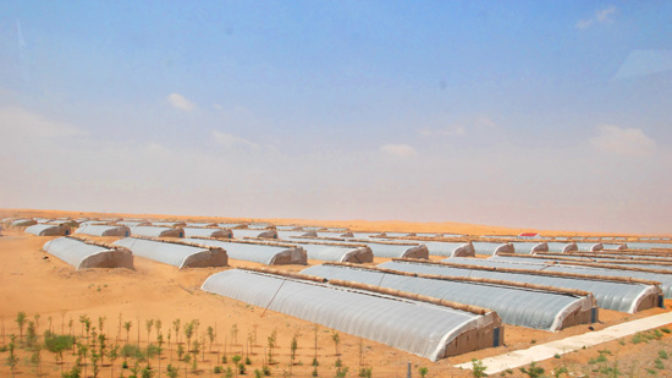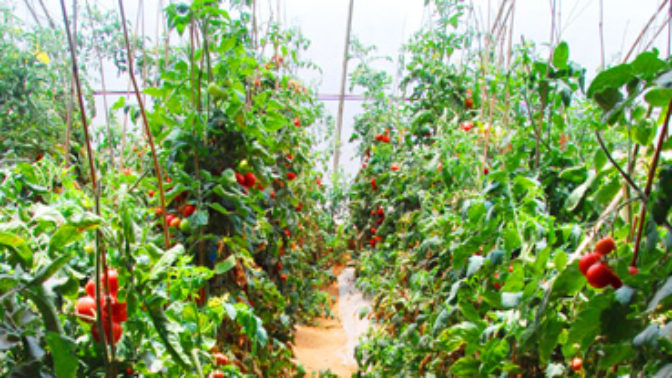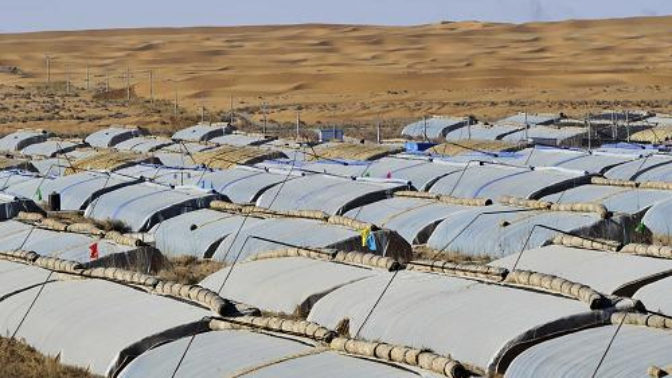Desert Greenhouse
The Desert Greenhouse turns wasted sandy land into arable land fit to grow 30 different kinds of fruits and vegetables.
Key Facts
- There is an increasing number of wasted desert lands in the world.
- The Desert Greenhouse solution has been successful in providing vegetable and fruit supplies to people living in desert areas.
- More than 30 kinds of fruits and vegetables can be planted in Desert Greenhouses, including: eggplant, tomato, pepper, cucumber, potato, leaf lettuce, watermelon, etc.
- In China, depending on individual productivity, an adult farmer can operate and manage about 3 to 10 standard Desert Greenhouses.
- Xinjiang Shawan Oasis Sustainable Development Institute plans to scale up its Desert Greenhouse solution in more developing desert countries.

Key Features
The Desert Greenhouse is great innovation that turns wasted sandy land into arable land to plant vegetables and fruits, increasing the area of arable land and output of agricultural products with high quality.
According to scientific inspection and verification, many desert areas possess good natural conditions which can be developed and utilized to build greenhouses. Due to the scarce rainfall, straw, twigs and other organic materials are valuable building materials in desert areas. Sand is, especially, an inexhaustible source for construction and cultivation substrate.
Using these cheap resources to construct greenhouses, planting can not only save costs for construction and operation, but also achieve organic cultivation. Thus, building greenhouses for vegetable production in the desert has very good social, economic, and ecological benefits.
Few organic substances are required for the growth of crops on sandy land. Grooves of a certain size and depth are dug, which can hold tree bark, sawdust, poultry manure, or oil cake mixed evenly with sandy soil. When fully fermented, this mixture creates a vegetative environment in which seedlings can be planted.
The Desert Greenhouse project is not only a great solution for the supply of agricultural products, but also a solution with great environmental and social benefits.
Social Impact
There is an increasing number of waste desert lands in the world, reducing the availability of agricultural land and agricultural yields. Thus, prices for agricultural products go up and the quality of life for low-income people decreases. Furthermore, people in many developing countries are forced to leave their homes because of the threat of desertification.
This solution will help overcome the challenge of desertification by turning wasted desert land into productive agricultural land. People will be able to make a better living from the so called “useless desert land” because of this innovative and profitable application.
The cost for a typical Desert Greenhouse is about $7,200 USD, which includes building materials and construction worker salary. If build in a larger number, the costs for greenhouses can be further reduced because of economies of scale. These expenses are very affordable in the proposed sales market, particularly when the investment return period is considered. Typically, a Desert Greenhouse investor can recover his/her investment within 3 years.
The Desert Greenhouse solution has been successful in providing vegetable and fruit supplies in desert areas and can also help to create many direct agricultural jobs for planting, daily operation, and harvest of planted vegetables. More than 30 kinds of vegetables can be planted in Desert Greenhouses, including: eggplant, tomato, pepper, cucumber, potato, leaf lettuce, watermelon, etc. With respect to the production of eggplant, a typical Desert Greenhouse with an area of 600 square meters can produce about 7,000 kilograms of eggplant annually. Based on the average vegetable consumption of 0.5 kilogram for an adult per day, the vegetable output of a typical Desert Greenhouse can satisfy the need of sufficient vegetable supplies for 38 adults. Data shows that the quality of these plants are far better than that of products from regular ground greenhouses. The annual amount of real harvest from each of these Desert Greenhouses is about $3,200 USD.
The Desert Greenhouse solution can also create agricultural jobs. A typical greenhouse covers a piece of desert land with a length of 30 meters and a width of 20 meters. In China, depending on individual productivity, an adult farmer can operate and manage about 3 to 10 standard Desert Greenhouses; there is also a lot of possibilities for senior people to also engage in agricultural production inside Desert Greenhouses with reduced workloads.
In terms of positive environmental impact, the Desert Greenhouse solution helps reduce and stop desertification and improves the environmental quality of desert communities.
Future Plans
Xinjiang Shawan Oasis Sustainable Development Institute plans to scale up its Desert Greenhouse solution in more developing desert countries with insufficient domestic food supplies through more cooperative project work with various individuals and organizations in environmental, conservation, and development fields in the future.
We are also developing new technologies to make our Desert Greenhouse solution suitable for all desert regions with no ground water and underground water.
Main Target Group
Desert region communities.
Main User
Farmers in desert regions and investors in desert agriculture.
Price (in USD)
$7,200 for the basic model.



